Gabriel Jungroth’s purpose-built Ironhead flat tracker…
One of the highlights of Milwaukee’s annual Mama Tried Motorcycle Show is Flat Out Friday, an indoor flat track race held on a small concrete track coated in Dr. Pepper syrup! It’s the USA’s wildest and most beloved indoor flat track event:
“Expect the unexpected at Flat Out Friday. In the past there has been a marriage, an impromptu wrestling match, and more — all right on the track in between races. The fierce competition on the track provides the perfect balance between laughs and thrills during the event. Part race, part rock show and part circus it all adds up to 110% entertainment.”
Earlier this month was the 7th Annual Flat Out Friday, which made its long-awaited debut at Fiserv Forum — home of the Milwaukee Bucks NBA team! There were two-wheeled jet skis, flying porta-potties, plenty of killer racing, and our friend August Zeratsky (@azeratsky) of Rosies Speed Shop even took home the trophy in the vintage class.
While checking photos of the action, we stumbled across one incredible Harley-Davidson Ironhead tracker and had to learn more. It’s the work of Gabriel Jungroth, a native Minnesotan whose family has deep motorcycle / chopper roots in the Midwest. He built his first bike in his bedroom at 17, his first chopper at 25, and in 2015 he attended Flat Out Friday for the first time:
“We made our way out to Milwaukee that winter to bear witness to the wild display of indoor concrete motorcycle racing. Instantly I knew I was going to be back the next year with a race bike going around in circles with the rest of the rabble.”
After racing on a Yamaha XT500, Gabriel decided it was time to step up to a Harley. He picked up a 1974 XLCH that hadn’t run in 40 years, spending all that time sitting outside on a farm in Colorado! Many racers avoid the Ironhead, as the low-slung primary cover makes it difficult to achieve the lean angles necessary for flat track, but Gabe was up to the task.
“The concept of this bike was to not only race short track indoor and on dirt tracks in my AMA district but also make it capable to race in the winter on ice and on single track in the summer. I wanted a multipurpose race machine, so the biggest hurdle was road clearance and fully adjustable suspension.”
Below, Gabe details all of the thought, research, fabrication, and support that went into resurrecting a forgotten Ironhead and transforming it into a purpose-built race machine, nicknamed “Fenrir” after the great wolf of Norse mythology.
“One thing I am most proud of on this bike was designing the bike so that I could lean it all the way over until the handlebars touch the ground without the primary cover touching. That is a major issue with these Ironhead Sportster and a big reason why no one races them. That was my main challenge in this build and I’m happy I was able to figure it out.”
So are we, Gabe, and we’re thrilled to showcase “Fenrir.” Photos courtesy of Gabriel’s talented girlfriend Sam (@sam.ray.m), @chicken_fried_choppers, and Gabriel himself.
Ironhead Flat Tracker: In the Builder’s Words…
My name is Gabriel Jungroth. I grew up in the small Minnesota town of Elk River. At a young age I learned that my family had a big part of the motorcycle history in the midwest and the chopper culture. Before I was in my teen years I was hooked on two wheels. I started building my first bike in my bedroom when I was 17 and built my first chopper when I was 25.
Then in 2015 my friend and I heard about an indoor flat track race in Milwaukee connected with the Mama Tried Moto Show. We made our way out to Milwaukee that winter to bear witness to the wild display of indoor concrete motorcycle racing. Instantly I knew I was going to be back the next year with a race bike going around in circles with the rest of the rabble. Sure enough I had found an old 1977 Yamaha XT500 and built it into my first vintage race bike. That first year of racing taught me a lot and instilled the race fever in me even stronger. Fast forward three years and it was time to step up to a bigger bike and more so one with an H-D stamp on it.
A few months of searching ended with an online post of a friend that had an early 1970’s Ironhead chopper that he was parting out. I got in contact with him and we made the deal. Turns out the bike hadn’t run in 40 years and had been sitting outside at a farm for all that time in Colorado. All that I got from him was the frame, motor, and a box of old chopper parts.
The frame and motor had matching numbers and was manufactured in 1974. The model was the XLCH, so it was a kick start only and being from 1974 made it the last year of the right hand shift. This was perfect because I had converted my previous race bike to a right hand shift also and was used to it at this point.
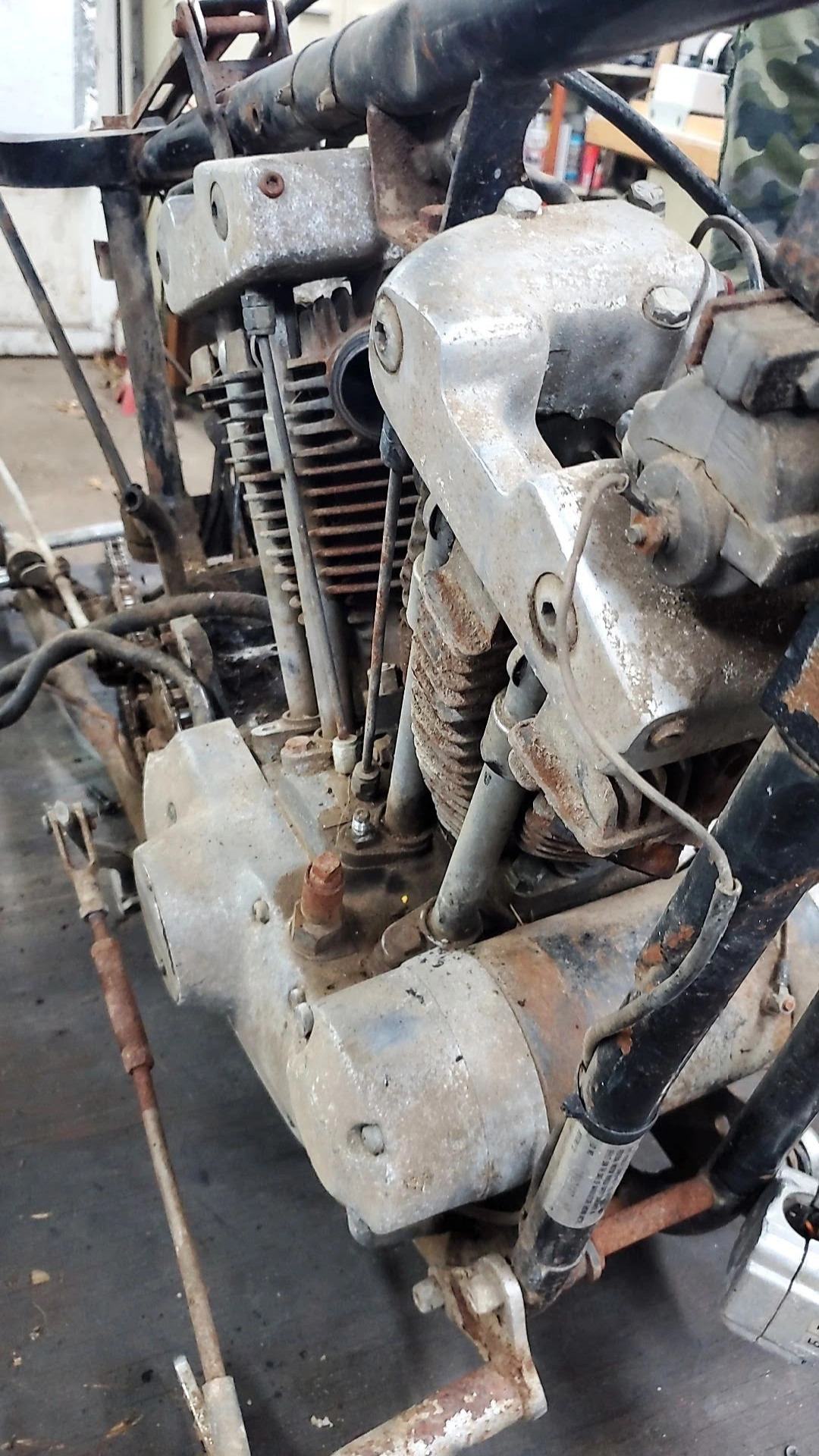
My original plan for the bike was to make it purpose-built for flat track racing, but specifically to be able to run it in not only vintage and open twin cylinder classes but also be able to run it in brakeless classes. My main inspiration for the build came from the classic look of indoor flat track race bikes of the 1970’s. The concept of this bike was to not only race short track indoor and on dirt tracks in my AMA district but also make it capable to race in the winter on ice and on single track in the summer. I wanted a multipurpose race machine, so the biggest hurdle was road clearance and fully adjustable suspension.
So that being said, my first order of business was figuring out frame geometry and how I was going to raise this thing up so that the primary case wouldn’t scrape the ground when I leaned it over. The two ways I was going to achieve this were larger diameter wheels and taller suspension front and rear. I also needed it to be able to turn on a dime for the short paperclip shaped indoor tracks like that of Flat Out Friday. The 29° rake on the neck just wasn’t going to do.
I started out sourcing parts. I found a set of 41mm fork tubes off of a 2000 Yamaha YZF1000 Thunderrace. This would give me a front end that was not only fully adjustable and long enough to raise up the front half of the bike but would also be stout enough to handle the weight of the vintage twin cylinder Harley. I sourced two lower fork trees from a Yamaha R6 which would fit the 41mm tubes and give me just the right offset I was looking for.
The neck stem was too long for the stock neck on the frame so instead of cutting down the stem I decided to chop the frame. I had a gooseneck frame section from an Evo Sportster that I picked up from a swap meet a few years prior. The neck on an Evolution Sportster is not only longer than the stock Ironhead neck but also larger in diameter. This would allow me easier access to bearing conversions for the R6 stem and enough length to make it fit perfectly. So I removed just the neck portion from the gooseneck frame section and carefully cut the stock neck off at an angle that when I welded on the new Evo neck it would bring my rake from 29° to 25.4°.

Thanks to a digital angle finder and my chop source frame jig, the whole operation was quick and easy and also exact. I finished the neck off by plating each side, not only for strength but also to give it that 70’s framer look. Now with a bearing conversion and some machining on the triple trees that I did to make the lower R6 clamp work for a top clamp and for fitment of the handlebar risers, the front end was done.
The back of the frame now had to be adjusted to match the front. I started with 14.5″ KYB adjustable shocks off of a 2002 Kawasaki ZRX1200r. These shocks have an attached reservoir and fully adjustable dampening and preload settings. The shocks were only a half inch longer than the stock suspension, so while I had the bike on the frame jig, I added another set of shock mounts to bring the frame up level with the ground. Also by keeping the stock shock mounts it allows me to lower the ride height down if needed.
Because I ended up using the stock mounting studs for the rear suspension I needed to put them on the lathe to shave them down to make them fit the mounting holes on the new shocks. I also made aluminum spacers to take up the extra length on the studs and to allow me an area for the rear stand to fit onto. The frame now had its set stance.
Next up were the wheels. I knew I wanted a set of 19″ drop center Akront rims that were originally used as the front rim of this year Sportster. I did some searching online and found two matching rims from 1974. They were, not surprisingly, in pretty rough shape. I started by removing the old steel spokes and the stock hubs. One of the the stock front hubs I kept, and with the lathe removed the caliper mounting brackets, shaved down the width, trimmed off some extra girth and bored out the center hole for larger bearings to accept the larger modern front axle. I then made new spacers out of aluminum to center the new improved hub. With the old steel spokes gone, I found new stainless ones for a replacement, laced them up, and had my good buddy Kyle Dahl who is a pro at tuning wheels to get it running straight.
As for the rear I scrapped the old spokes and the hub. I needed a quick change hub so that I could easily change out gearing and be able to flip the wheel for a new side of the tire on the fly at races. My friend had an A&A quick change hub for sale and I jumped on it. The spoke hole count matched the rim so I could lace it with the same stainless spokes as the front with some help from Buchanan’s Spoke & Rim, Inc.
I ended up wanting to keep the stock swing arm so this meant having to use the stock rear axle. The problem was the axle was a standard size and the rim was metric size for the bearings, so it was back to the lathe. I had to bore out the bearing hole and inset the depth to accept an oversized outer race and wider bearing. I also, with a little research, decided I would go with a spacer design that some newer KTM and other motorcycles use, where the inner race of the bearing rides on a stepped portion of the spacers. This allows for easier alignment of the axle while reinstalling the wheel after a gear change or tire change, etc. These spacers were also made from aluminum that I turned on the lathe.
I also had to adjust the width of the rear hub so that it would not only fit the sprocket and brake rotor but also align with the front drive sprocket, so I shaved down the sprocket and brake rotor carriers to accommodate this spacing. As for the rear brake, I used a Brembo OH29 32mm caliper that I paired with an Arashi rotor and a Barnes-style adapter bracket to bolt onto the quick change hub. I made a custom aluminum floating caliper hanger bracket to mount it to the spacer on the axle. I also had to make a custom mounting bracket that I welded onto the swingarm with an adjustable rod for the caliper stay.
As for the the rear sprocket, I had Sprocket Specialists machine custom 530 sprockets to my said dimensions that would fit the Barnes-style A&A mounting configuration and they turned out great! I am currently running a 62 tooth for the brakeless class on an indoor short track. Now with the larger diameter rear wheel size, I ran into a clearance issue with the rear frame supporting bars rubbing on the tire. To fix this I simply made another matching set and one at a time cut the old ones off and welded the new ones on at a further distance apart. This allowed for full wheel adjustment for chain tension with different sprocket sizes.
I now had a rolling chassis. The next step was a battery box and an oil tank. The battery box I custom-made out of aluminum and it doubled as a seat mount/sub frame. It holds a ultra lightweight anti-gravity battery and is up high and away from any extra heat that the motor would otherwise subject the sensitive battery to. The oil tank I modeled after the 1950’s style Harley Davidson KR sportster horseshoe oil tank. I hand-fabricated the entire unit out of aluminum for weight and heat reduction. I welded some mounting brackets to the frame and made some 1″ rubber spacers to reduce harmonic vibration into the aluminum.
For the fuel tank I went with a fiberglass Knight style made by Randy Thistle at Gopher Glass, a native to northern Minnesota and a fellow AMA district 23 flat track legend. I made a custom stainless steel mounting bracket for the single bolt mounting style that clamps onto the frame’s backbone. As for the seat, I went with a fiberglass Champion style tail section that my good friend Erik Moldenhauer made from a mold and padded it with a cut-out from a garage floor mat attached by velcro. The tail section utilizes a single bolt front and rear secured to the battery box/subframe.
Now with a seat I could figure out my foot peg mount. I used 3/8″ thick aluminum plate for the mounting bracket which bolts onto the outside of the stock chain guard. I made an aluminum footpeg and hinge mount and slipped on the original vintage Harley Sportster foot peg rubber to give it that classic look. The aluminum brake pedal which I salvaged from a Yamaha also mounts to this plate and pushes fluid through a Brembo master cylinder mounted just under the peg. I mounted the fluid reservoir just above and behind the kickstart shaft on the chainguard.
With my foot placement and brake pedal figured out, I was able to now fabricate a shifter to land in the right spot so as to have usability with both shift and brake lever. I took the stock shift lever that originally clamped onto a smooth shaft and instead machined a groove in the shift shaft so that a bolt would lock it into a fixed position for a more secure attachment. I also shortened the shift lever and angled it downward to land the shift peg in a perfect spot for ease of use. I then made a new rubber shift peg to replace the deteriorating original one.
For handlebars I went with Emgo’s wide 7/8″ flat track bars that I got from Minnesota’s own Dennis Kirk. I went with Motion Pro’s 1/4 turn quick throttle, MPS kill switch with the body tether, and an aluminum clutch lever from a Yamaha that I had laying around to finish off the handlebar controls.
So now with most of the components figured out I drew my attention to the 47-year-old AMF motor. It had sat outside for 40 years and you could tell. I started with cleaning the entire motor top to bottom. After pulling out and cleaning the mouse nest in the primary and transmission, I replaced the clutch with a Barnett wet dry clutch plate set and clutch basket, new kickstart setup, new primary chain and tensioner, and a new primary drive gear and spring.
I found that one of the lifter seats had chipped and broke a few teeth in the cam gears and oil pump gears, so I rebuilt the cam side and oil pump with new components also. The valves were stuck and frankly shot so I had my good friend and only sponsor Tim Wolff at Wolff Motorcycle go through the top end and replace valves, springs, and seats, and give it a port and polish. I also punched the cylinders out .010 for a refresh with new pistons. I upgraded the charging system to an alternator and because of the spinning motion and the potential of rocks coming off of the front wheel and getting lodged in it, I added some stainless screen to the front of the frame to block any debris. I also upgraded to an S&S HI4N electronic ignition system and then finished off bolting the motor together with all stainless steel allen head bolts.
My exhaust pipes started as a builder set from TC Bros that I fabricated and welded into a one-off scrambler-style dual exhaust system. I wanted to keep to that scrambler/high pipe style to somewhat honor the exhaust styling of the XR750 factory Harley race bikes of the 1970’s with my own flair to it.
For the carb I’m currently running a Mikuni 38mm round slide but I just acquired an S&S Super E for some better performance. As for my clutch cable, throttle cable and brake line, I went with all braided stainless from Barnett. The number plates, especially the side plate, came from the design of a lot of indoor flat track race bikes of the 1970’s. The side plate I made from an old aluminum street sign and the aluminum front plate I got from Dennis Kirk. My girlfriend Sam Ray and my dad helped me paint the number plates the tank and tail section and the frame.
As for a nickname, I think Fernrir (the giant wolf of Norse mythology), is suitable in many ways…
So the bike’s maiden voyage was this year’s Flat Out Friday. It was nerve racking because it was the first time racing it but I have to say I couldn’t be happier. The handling was amazing and it has more power than I know what to do with. I ended up making it to the finals at FOF but had an issue come up with the timing and wasn’t able to make it on the track but that’s just how racing goes sometimes. Now that I’ve had more time for tuning and am able to fix a couple small issues, I’ll be coming back this coming year with my dream bike ready to lay down some rubber.
One thing I am most proud of on this bike was designing the bike so that I could lean it all the way over until the handlebars touch the ground without the primary cover touching. That is a major issue with these Ironhead Sportster and a big reason why no one races them. That was my main challenge in this build and I’m happy I was able to figure it out.
I have to thank my good friend Erik Moldenhauer, my girlfriend Sam Ray, and my dad for always supporting me and helping me out with advice on so many problems along the way. Zac Doom from Heavy clothing for always supporting me along with my sponsor Tim Wolff at Wolff Cylinder Head for all the help on everything.
Photo Credits
Photo credit on the photos at Flat Out Friday and the photos of me on the bike and working on it in the garage goes to my talented girlfriend Sam (@sam.ray.m). The photo of me pushing the bike with the backpack on was taken by @chicken_fried_choppers. All the photos taken at night in the snow were taken and edited by myself.
Builder Thanks
Wolff Motorcycle
@Heavyclothing
@flatoutfriday
@mamatriedshow
@harleydavidson
@ftwco

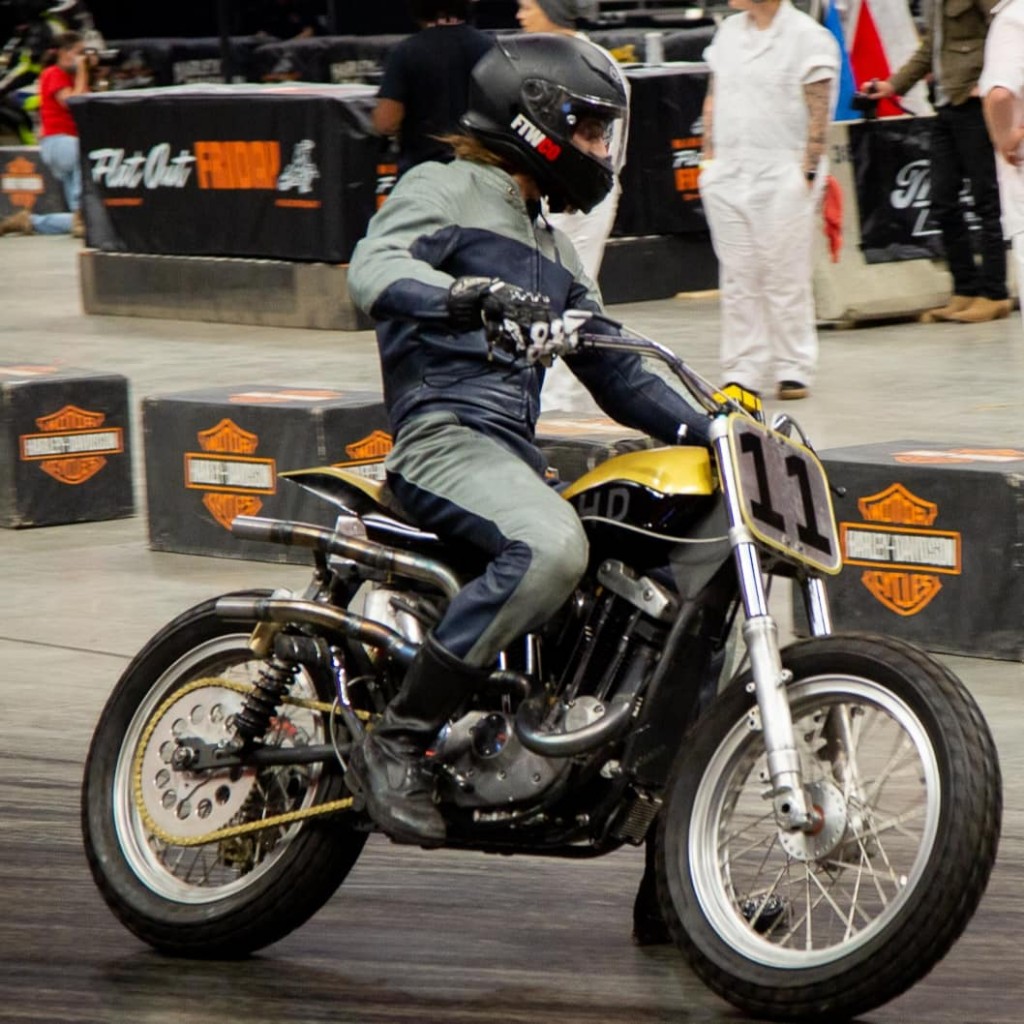

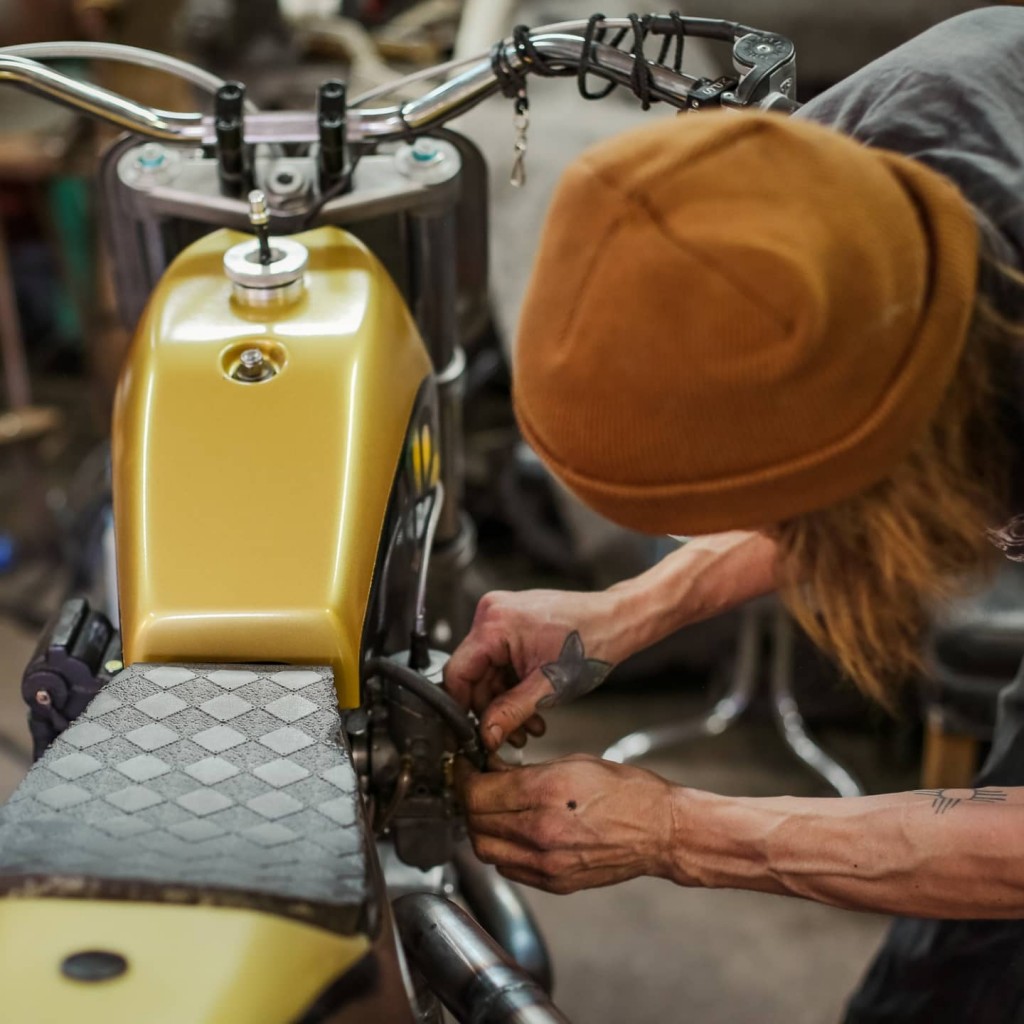



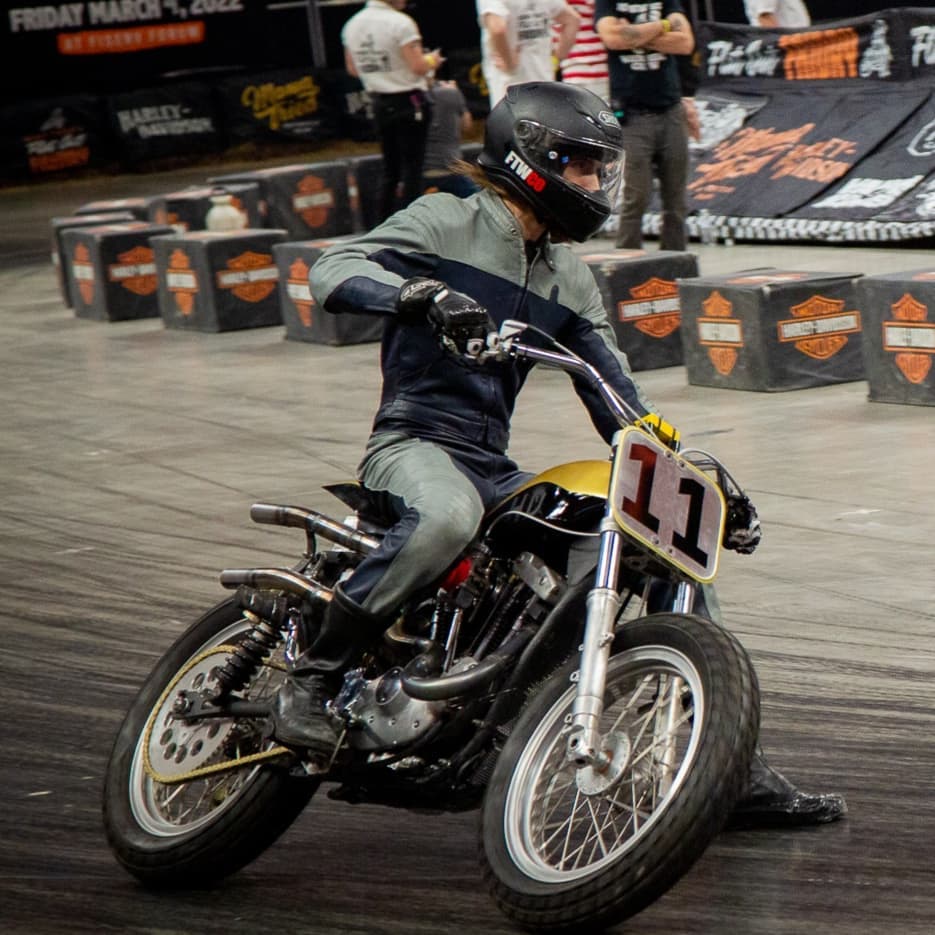
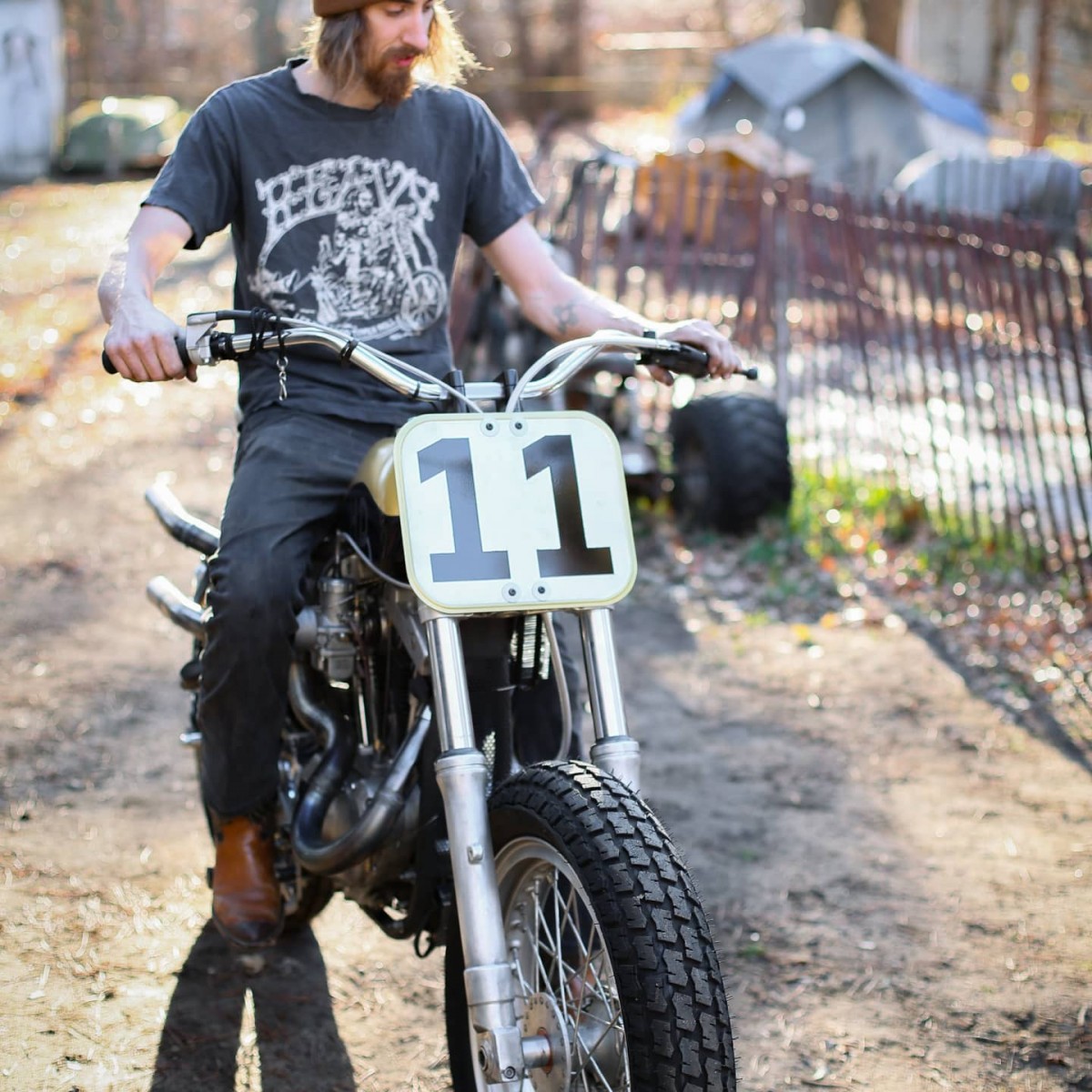





Excellent build, looks like a fun ride, enjoy.
Nice flat tracker you did well still love my 750 HD
Congrats to the builder for that wild & personal design, photographed with moon light.
Sincerely,
Philippe from Paris 😉